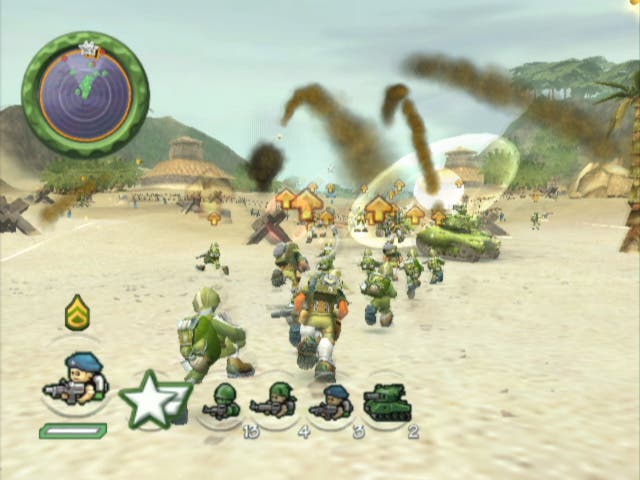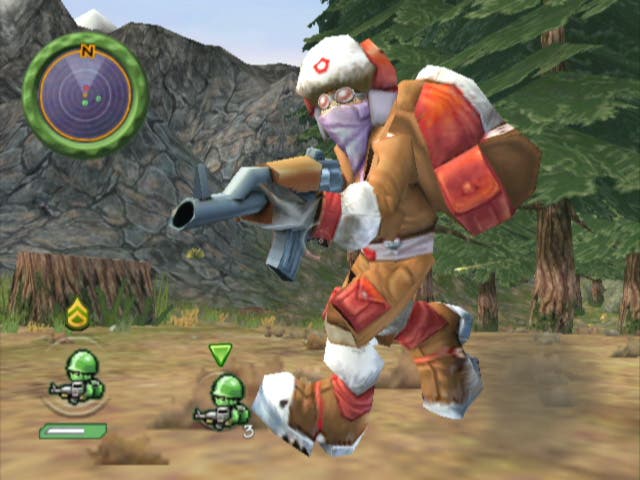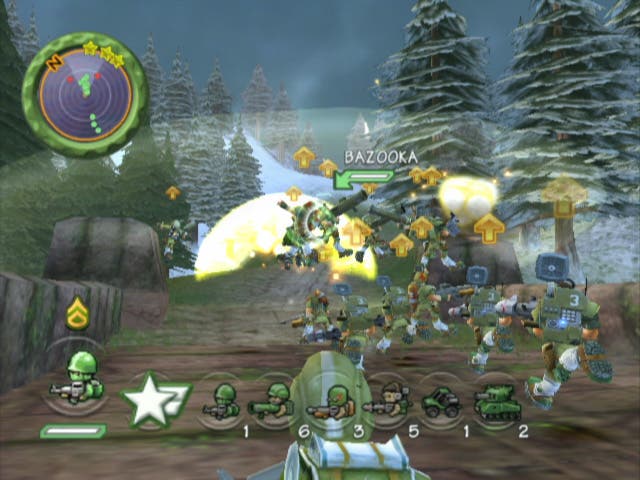Battalion Wars
Cannon Fodder.
Turning one of the most beloved turn-based strategy games into a real-time, third-person action title was always asking for trouble, so Nintendo changed one word of its name and hoped fans wouldn't notice, or at least complain less bitterly. Good move.
But the belated re-branding of Advance Wars: Under Fire to Battalion Wars can't disguise the endless close similarities between the two games: the mission structure, the units, the cutesy cartoony style, the silly-yet-endearing briefings, the daft characters and even dafter rivalries, the changing allegiances, the grading system, you name it. In fact, just about the only that's nothing like Intelligent System's classic series is the actual gameplay itself; and it's evidently this point that forced Nintendo to see sense and divorce the association lest it get beaten about the face and neck by rabid fanboys and girls.
It's not even as if the gameplay's even remotely similar. Far from being a more exciting looking turn-based chess-like affair that takes place on a top-down map, Battalion Wars is a curious hybrid of third person shooter and real-time strategy, and - surprisingly - a pretty well-realised attempt at it, too; if a little undemanding, short and overtly 'young' for the most serious gamers' tastes.
Whether Kuju deliberately designed a 'my first RTS' for the kids isn't especially clear. Certainly, Advance Wars may have a similarly cute, kid-friendly approach on a basic level, but it's a wolf in sheep's clothing; a game that never shirks at providing one of the most hardcore challenges around. In Battalion Wars, though, it's largely a game that not only leads you by the hand, but is over and done with pretty quickly and nowhere near as challenging, either.
In the main, it's straightforward run and gun action: you take control of the most powerful unit, lead the others around with you, rescue PoWs, take out enemy gun towers, capture bases (or defend your own), wipe out stray soldiers, recon units, tanks, and eventually air units. But getting there requires more than a little forethought, and with so many different types of units to get your head around, it's a game filled with plenty of fast-paced trial and error. It's definitely a lot of fun, though, and so long as you've left your Advance Wars hang-ups at the door, it's a game that deserves a fair amount of recognition in its own right. Put it this way; you won't play too many games like Battalion Wars.

Even so, you can�t help but recognise where the two titles overlap; but that's fine when you're borrowing good game design. In common with the AW titles, the first few levels are there purely to introduce you to the controls and game mechanics, and in this case you get direct control over any - or all - of your units, and get to be the one pulling the trigger on the enemy. In typical paper, scissors, stone fashion, each unit has its own set of specific strengths and weaknesses. So, for example, on the Infantry side you get basic Rifle Grunts, Assault, Frame, Bazooka, Missile and Mortar units, with each providing a vital role in the war effort, but each suffering from chinks in their armour which are up to you to brutally expose.
So, while Bazooka units are great at dealing with mid-range tanks, they're hopeless against other infantry as their projectiles are so easy to dodge. Meanwhile, ground Recon units are fast and ideal for scouting, they�re vulnerable to machine gun fire; Gunships are fast, nimble way to deal with tanks but susceptible to anti aircraft units like the Missile grunts. And so on.
But much of the time you don't really have to furrow your brow too hard to suss out a way through enemy lines; simply blitzing the most dangerous units first (tanks, gun towers, aircraft) and following the advice given to you will get you through the majority of the game in no time at all. It's only later in the game where you have to pay serious attention to the tactics - or if you're particularly concerned with getting a high rank for your efforts and unlocking each of the four campaign's bonus mission.

Part of the reason it's a simple game to get to grips with is due in part to a largely slick and intuitive control system that makes it a cinch to gain full command over them with the flick of the C stick. Once you've cycled through which unit you want direct command of, you hit the Z button and control them just as you would in any other third person action game, with the dpad also allowing you to zoom out for a broader view of the battlefield (while keeping you in full control over your unit). Targeting is reasonably effective, giving you the ability to lock onto any target near your cursor with the L button and fire with the A button. You can also go into a free aim mode with the R button, but the game seems rarely requires you - and besides, it's often less effective to do this in the heat of battle.
It can a bit of a pain to effectively get a lock-on on aerial units, though, especially when they're directly overhead, requiring you to move somewhere else to even get your cursor near them. Regardless of whether you're in a ground or air unit, you can always issue commands to specific units (or the whole lot if you want), instructing them where to move to, who to attack, or whether to remain in sentry mode and attack anyone who comes near - all via the X and Y buttons. On the whole, the system's fluid, reliable, instinctive and flexible, although there's one major flaw in not being able to instruct a specific unit to go somewhere. For example, if you have seven Rifle Grunts, you can't order three to go one way, and the other four to flank the enemy from another side - you simply have to tell the whole lot to go in one specific place, which - naturally - can be a risky business. Likewise, the inability to split up tank units is a major restriction placed upon you, with the only halfway house solution to go it alone and do your flanking solo while the others cause a fuss somewhere else.
It's certainly a lot of fun being a direct part of an ongoing war effort without being just the pointer and clicker. If there's one thing that's lacking from most RTSs, it's the satisfaction of knowing you're the one out there dishing out the punishment, and Battalion Wars definitely goes some way to addressing that - but it's a halfway house that introduces problems of its own. It's all very well giving making an RTS action hybrid, but you still need to give the player as much control over the units as a normal RTS or the whole thing has to be reduced to a bit of a tank rush - which is what Battalion Wars descends to for much of the time.

Also, with such a simplified interface, the whole resource management side of the genre isn't explored at all, with new units and back-up introduced via means of simplistic rescue sorties and the occasional arrival of back-up via T-Copter. The in-game map, as well, is utterly redundant, using a crazy magnifying glass system over an unintelligible map that makes it especially hard to plan any kind of strategy. Why Kuju couldn't have just aped AW's top-down map, we have no idea.
Another area Kuju has completely cocked-up is the driving side of the game. With physics that have more in common with the Moon than anywhere else, you'll be exasperated by the crazed floaty behaviour of the Recon units, and driven to distraction when the camera decides to go completely mental trying to keep up with whatever bizarre back-flips the game tries to make you do every time you hit something. On the other hand, control over all the other units is generally fine; air units are a breeze, infantry are always a pleasure to command, it's just the odd occasion you'll find it a little inelegant; like trying to squeeze a tank through a crowded area, again, affected by camera issues and an overly wobbly steering system.
In technical terms it's by no means pushing the GameCube to any great degree, but still scores points with a cute, rounded, cartoon art style that makes light of a serious subject matter. In fact, we'd probably not have enjoyed the game anywhere near as much if it went for a straight, serious approach.

What strikes us as particularly disappointing is just how little there actually is to the game. Once the 20 mission campaign is done and dusted, there's no War Room, and not even a hint of multiplayer, never mind secret modes and so on. For a game loosely based on something that's absolutely rammed with extras, it's a curious decision.
For the right price, Battalion Wars is still worth a look, though. Despite the odd camera and control niggle, it stands out an unpretentious and largely unique example of how to blend strategy and action in a relentlessly entertaining way. The fact that there's little more to it than a solid 10 hour single player campaign will be disappointing for some, but don't let that put you off what is one of the better GameCube exclusives around at the moment - a rare beast, as we're sure you realise�

